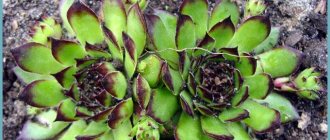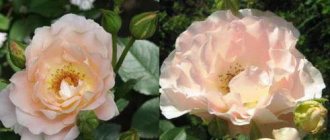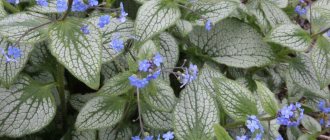Description of the variety
Rose Abracadabra belongs to the Rosaceae family , a variety of hybrid tea roses. This is a perennial plant in the form of a spreading or erect bush; it is also possible to have a form in the form of a standard tree, with a height of 50 to 150 cm. The stems are dark green and spiny. The leaves are green, glossy, hard, and when grown in open ground they can acquire a brownish tint.
Abracadabra flowers are large, from 8 to 12 cm in diameter, double, with a high center and pointed velvety petals. They can either be located singly on a high peduncle or be collected in inflorescences of several pieces. The “highlight” of this variety is the color of the buds: a bizarre combination of all shades of yellow, red, white, brown, and sometimes purple will not leave anyone indifferent.
Rose has a faint pleasant aroma, reminiscent of women's perfume. With good care, it can bloom several times during the summer, and in greenhouses - almost all year round. The advantages of the variety include the fact that, although it is a cut plant, the rose takes root well in open ground. However, we should not forget that it was originally intended primarily for cultivation in greenhouses, as a cut variety.
As a result, Abracadabra has the following characteristics :
- winter hardiness – average (climatic zone 6a (from -20.6C to 23.3C) – 9a (from -3.9C to -6.7C));
- disease resistance – average (especially to powdery mildew);
- rain resistance – weak;
- drought resistance – average;
- requirements for the acid composition of the soil - from 5.6 to 7.3.
When cut, Abracadabra lasts up to 16 days, which allows it to be used to create spectacular bouquets.
Features of application
Most often, Abracadabra is grown for its intended purpose - for cutting. Thanks to its powerful flower stalks, which accumulate a lot of nutrients, it is stored in a vase for a long time (at least two weeks), and its unusual flowers perfectly complement bouquets, giving them an unusual charm.
At the same time, the variety is often cultivated in open ground, especially in the southern regions with mild winters. It should be remembered that the bushes are guaranteed to survive frosts of at least -10°, but they require reliable shelter.
A tree or spreading bush of Abracadabra will decorate any flower garden or garden plot. Usually it is planted in plain sight, delegating the plant the role of a dominant. The variegated colors allow designers to combine this variety with most other roses, as well as with many flowers, bushes, and even trees.
1991
Photo
Next in the photo you can see what the Abracadabra rose looks like.
History of origin
Speaking about the history of the creation of such an unusual variety, it is necessary to mention that today it has three varieties:
- Abracadabra hybrid tea.
- Abracadabra floribunda, Kordes, 2002.
- Abracadabra floribunda, Kordes, 2004.
The first of them, Abracadabra hybrid tea, is the ancestor of the entire series. It was created in a California nursery by the American William Warriner in 1991 by crossing a tea rose and a remontant rose. The basis was the varieties “White Masterpiece” and “Tribute”.
Two years later, in 1993, Abracadabra was exhibited by the Jackson and Perkins Company, and quickly gained public attention and recognition. The next two varieties were created in Germany, in the nursery W. Kordes & Sons, using the then popular variety Hocus Pocus, in 2002 and 2005, respectively.
What is the difference from other types?
First of all, Abracadabra differs from other types of roses due to its extremely original colors. In terms of unusual color, it is comparable only to the Hocus Pocus variety, but Abracadabra has more stripes on its petals. Also, unlike its progenitor, which can fade over time to the same type of burgundy, it consistently maintains its variegated color. Among its advantages is ease of propagation: it reproduces well by grafting, budding and cuttings. Planted bushes can bloom the next year . Suitable for dry regions.
Bloom
With the right choice of planting site, Abracadabra blooms luxuriantly and abundantly almost all summer. If you plant it in the ground in the fall, then in the first summer the variety will produce buds. The rose fades before frost, and after the cold weather the flowers do not last. The exception is greenhouses, in which Abracadabra can bloom all year round.
Sometimes, in the first year of flowering, Abracadabra produces exclusively yellow buds, but you should not classify the bush as defective. Already next summer, the rose will surprise you with its bizarre flowers, among which it will be impossible to find two identical ones.
During flowering, the plant requires the same care as usual. A flowering bush should not be fed , but after complete flowering, as well as during periods of decline in flowering, Abracadabra needs fertilizer. Watering is standard. Also, as they fade, you will need to remove faded buds - this will stimulate the appearance of new ones.
If Abracadabra does not bloom, then most likely it is due to the wrong choice of location. It is necessary to protect the plant from drafts and ensure that it receives diffused sunlight. If you planted a rose in the shade of trees, fences or buildings, you can’t expect flowering, it won’t happen. The problem may also be unsuitable, poor soil. There is an opinion among flower growers that this variety blooms best on black soil.
Reviews
Valentina
I accidentally bought a small rose bush at a local market a few years ago. The name of the variety – Abracadabra – really caught my attention. But the seller said that this is a very valuable variety, although it costs a penny. But I still bought it, although I didn’t expect it to grow anything useful. However, in the summer the bush grew thoroughly, it was about 70 centimeters high. Buds appeared in July. They were white on the outside, but when they bloomed, the color changed. This variety blooms with a two-color, not too lush, red-burgundy flower with yellow splashes. Moreover, roses of different colors can bloom on one bush. Some flowers are covered with a marble pattern, others are divided in half by color. If several Abracadabra bushes are planted in a flowerbed, then no other flowers are needed, because such colorful roses alone can decorate a flower garden so much that you will fall in love with it. In general, this is a very worthy variety. Although, I think all roses are beautiful, no matter what variety they are.
Alya
The Abracadabra variety is notable for its interesting flower colors. You never know what kind of flowers you will get - all the bushes produce completely different inflorescences. This rose blooms for a long time and numerously. Quite unpretentious, frost-resistant. It tolerates drought well, but it is better not to experiment. In hot weather, roses need to be watered daily. Once a month you need to feed the bushes. They respond very well to feeding and immediately renew themselves and continue to produce new buds. During the winter, it is necessary to carefully cover the roses, otherwise they will freeze even in a not too cold winter. First, it is better to sprinkle it with sand, and only then cover it with protective material.
Use in landscape design
This variety of roses, due to its bright and unusual colors, is highly valued in landscape design. With its help you can decorate any garden or park in an original way.
The classic background for the Abracadabra rose is considered:
- Combination with coniferous crops: spruce, juniper, thuja.
- Any climbing rose with monochromatic buds is planted behind Abracadabra to highlight its unusual colors. Such a flowerbed would look appropriate at the front entrance.
Any flowering and fruit shrubs can be planted at a distance of 1.5 m from the flower bed with Abracadabra. The rose goes well with such crops as lilac, mackerel, yellow acacia, cotoneaster, euonymus, snowberry, oleaster, sea buckthorn, privet, tamarix, mock orange.
You can also place it next to mahonia, pyrocantha and horizontal cotoneaster. Among perennial plants, lavender, periwinkle, speedwell, bluebells, delphinium and blue and white asters are suitable as neighbors for Abracadabra. Of the annuals - lobelia, agerantum.
When combining Abracadabra with monochromatic flowers, it should be planted in the foreground. Then the end result will be a bright, memorable composition.
Step-by-step care instructions
Anyone can grow Abracadabra in their own area (if the climate zone is suitable), the main thing is to follow the recommendations for caring for this plant and plant it correctly.
Selecting a location
This is one of the main points on which it depends whether the rose will bloom and whether it will take root in principle. The variety requires an open, sunny place, blown by winds. The latter is especially important since the rose is not resistant to moisture and must dry quickly after rain and dew.
Otherwise, fungal diseases cannot be avoided. When growing a variety in the southern regions, you should pay attention to ensure that the plant is not located in the open sun. This will contribute to the appearance of sunburn on the petals. also necessary to take care of a slight elevation, since cold air accumulates in the lowlands, which is not beneficial for roses .
Timing
It is optimal to plant bushes in the fall so that the plant has time to get stronger and adapt before the onset of winter.
The soil
Blooms best on black soil. It can be planted in loamy soil, but it is important to ensure that there is no groundwater nearby. For acidic soils, liming is used, and clayey areas are improved by adding peat.
Landing
Abracadabra can be propagated by both seeds and seedlings . The first method is a little more complicated and is only suitable for experienced gardeners. It is best to take seeds for it that you collected yourself. If this opportunity does not arise, you need to carefully select the seeds. The packaging should indicate the harvest date and expiration date of the seed; it is advisable to take seeds from this year.
Also, the packaging must be intact, not wrinkled and without signs of heavy moisture. Purchased seeds should be treated with hydrogen peroxide, then placed on a damp gauze substrate, covered with another similar layer, placed in a cool, dark place and waited for germination. Plant the germinated seeds in small pots and wait until the seedlings grow up so that they can be transplanted into the ground.
Purchased seedlings should be selected with dormant buds , without green shoots, so that the seedling does not weaken, consuming nutrients. Externally, the bark of the seedling should look healthy, green, without spots, stripes or browning. It is also important to inspect the root system - it should not be damaged.
- Before planting, the root of the seedling is immersed in water for 6-10 hours.
- Then a hole is dug at least 0.5 m deep, and drainage is placed at the bottom.
- Organic fertilizer, such as compost, is added.
- Then the future rose is placed in the hole and carefully covered with earth.
- Immediately after transplanting, the plant must be watered.
Temperature
The rose is capable of growing in the range from +30 to -10 ° C (with shelter for the winter). The optimal temperature will be +20-25°C
Watering
Regular watering is required, but without waterlogging . Once a week will be enough. It is best to water early in the morning, at the root, then loosen the soil.
Top dressing
Required in March, April, June and July, at intervals of 8-9 days. It is optimal to use specialized complex fertilizers for roses or cow manure diluted in water for this purpose.
Weeding
Regular mowing is required, at least once a week, to prevent the formation of a soil crust.
Trimming
Pruning is required in spring and autumn . Spring is carried out until the buds awaken, with the goal of forming a beautiful bush and abundant flowering. Autumn, so-called preventive, is performed with the arrival of cold weather, in dry weather. The shoots are removed to the middle of the branch.
Transfer
There is no need to replant Abracadabra. The only situation in which this may be needed is during very cold winters. Then you should carefully dig up the rose, transplant it into a box with damp sand and place it in the basement.
Preparing for winter
The variety does not tolerate winter well , therefore, if the temperature drops below -5 ° C, the rose should be covered with spruce branches or garden polyethylene. It is pre-cut. It is important to check that dampness does not accumulate under the shelter, and to ventilate during periods of thaw.
Why don't roses bloom?
- Insufficient lighting. Roses are native to the southern regions, and for good bush health, abundant flowering and rapid growth, they need to be exposed to sunlight for at least 8 hours a day.
- Presence of drafts. Rose is a heat-loving plant, and drafts have a detrimental effect on it.
- Competition with other plants. Fighting for moisture and nutrients, the rose expends the energy necessary for growth and flowering.
- Too radical pruning. After this procedure, the rose takes a long time to recover, and the onset of the flowering period is postponed.
- The presence of faded flowers on the bush. Their timely and regular removal promotes the growth of new flowering shoots. It is also necessary in the spring to cut out thin, weak and inward-growing shoots and root shoots. They compact the crown, interfere with the free circulation of air and light, and needlessly take away the strength necessary for flowering.
- Insufficient, unbalanced or excessive feeding. The plant must be fertilized correctly.
- Aging bush. In the spring, you should cut out old (more than 3 years old) shoots that are no longer capable of producing abundant flowering. Young branches will grow in their place.
Reproduction
Abracadabra successfully reproduces by grafting, budding and cuttings. This is usually done in the fall or summer.
Cuttings
Reproduction begins at the end of June or July.
Necessary:
- Cut off semi-lignified annual flowering shoots.
- Take their middle part and divide it into segments, each of which should contain 2-3 buds. The bottom cut is made 3 millimeters below the last sheet. The bottom sheet is removed.
- Root the cuttings in a shaded place in the greenhouse.
- After rooting, plant in wet and dense soil to a depth of 1.5 cm.
- For the winter, transplant into pots and leave in a cool, bright place.
Budding
In this way, you can increase the number of varietal bushes in the second half of July or in August. The eyes are grafted into the root collar of one or two-year-old bushes or into a strong shoot.
Graft
In the spring, you can graft “into the cleft” or “behind the bark” with cuttings cut in the fall and stored under snow or sand in basements.
Hybrid tea roses are in great demand for decorating flower beds and garden plots. The reason for their popularity is their attractive appearance, resistance to disease and bad weather. On our website you will find descriptions and photos of the varieties First Lady, Taleya, Iguana, Explorer, Westerland, Red Naomi, Anna, Esperanza, Blush.
Growing a flower, how to plant it correctly in open ground
Planting is practiced mainly with seeds, as well as seedlings and cuttings.
What time does boarding take place?
The time for planting the varietal rose Abracadabra is not limited by strict dates. Spring time includes the end of April - beginning of May. Autumn – October month.
Autumn planting should be treated with special attention. It is advisable to land before the onset of prolonged bad weather.
Selecting a location
Select a sunny, well-ventilated area. Open sun is not suitable as well as a constantly shaded place. But the Floribunda Abracadabra rose needs protection from strong winds. Preference should be given to neutral or slightly acidic fertile loams.
How to prepare the soil and flower for planting
The soil is prepared in advance. The soil is dug to a depth of 30 cm. The soil is filled with organic and mineral fertilizers at the rate of:
- peat (also manure or compost) – 10-15 kg,
- mineral phosphorus - 100-150 g per 1 sq.m of soil.
If neutralization is necessary, lime or ash is added (up to 0.5 kg per 1 sq. m).
A hole measuring 40x50 cm is prepared, with drainage filling. The hole should be up to 70 cm deep. Crushed brick, expanded clay, and crushed stone in a layer of up to 10 cm are used as drainage. The third part of the hole should be filled with a substrate in the form of a slide.
Seedlings also undergo training, which consists of the following:
- roots are shortened;
- damaged roots are removed;
- shoots are pruned to 2-3 buds;
- the cuttings are dipped in a liquid mixture including manure and clay, based on 2 parts clay - 1 part cow dung.
You can revive the roots by dipping them in water for several hours.
Step by step landing procedure
After all the preparatory work has been carried out, the landing itself will not take much time:
- Carefully spread the roots of the seedling in the planting hole.
- Compact the substrate around the bush to protect the root collar from temperature changes, and fill the hole with soil.
- Water the plant, avoiding moisture on the shoots. This is necessary to protect against sunburn.
Attention! The root collar should be buried 5 cm below the soil level
Planting roses in open ground
Diseases and pests
In relation to this species, Abracadabra is not resistant to rust and powdery mildew. The first one is treated with 0.4% copper oxychloride, and the second one is treated with a 1% solution of the drug “Topaz”, a 1% solution of Bordeaux mixture or a 0.2% solution of the drug “Baleiton”. It can also be affected by spider mites, caterpillars, beetles and aphids. The drugs Sunmite, Mospilan, Confidor Maxi or Acrofit are used against them.
The Abracadabra rose variety can decorate any garden with its blooms. And, although it is not easy to reproduce and care for, when it blooms, it will pay off all the efforts.
Agricultural technology
Before planting seedlings of this hybrid, you should choose the right place for planting. The area should be well illuminated by sunlight, but it is better to shade the plant from the hot midday sun, otherwise the color of the petals may “fade.” Also, the place where Abracadabra will grow must be protected from gusts of cold wind.
Rose Vanilla
The soil on the site should be prepared in the fall - dig it up, while adding rotted manure or compost to the soil. In the spring, before planting seedlings, complex mineral fertilizers are applied to the soil. In this case, the hybrid tea bushes are not fed in the first season.
Planting Abracadabra seedlings is no different from planting other varieties of roses. But you should remember that when planted in the spring, the seedlings have time to take root well over the summer, therefore, by the time cold weather sets in, the plants will noticeably grow and become stronger. And when planting in the autumn, you should calculate the time so that the plant is planted in open ground a month and a half before the onset of frost.
Important! If the soil pH level is too high, then lime is added to the soil in the fall. At least 300 g is required per 1 sq. m.
Further care of planted bushes is simple and includes:
- regular watering at least once every 7 days; if the weather is dry and hot, increase the number of waterings;
- These plants should be fertilized with special fertilizers for roses, which can be purchased at any specialized stores. Many gardeners also recommend periodically watering Abracadabra with a solution of cow manure;
- Formative pruning of this hybrid shrub is carried out in the spring, removing dry, broken or frozen shoots;
- for preventive purposes, it is recommended in the spring to treat roses against rust with a solution of copper oxychloride (0.4%), against powdery mildew they use Bordeaux mixture or the drug Topaz;
- against major pests, it is best to treat these bushes with Sunmite, Mospilan, Acrofit or other similar preparations;
- after each watering, it is necessary to loosen the tree trunk circles to remove the emerging crust, as well as to remove weeds;
- Before the onset of cold weather, the bushes should be covered with spruce branches and on top with a special covering material.











